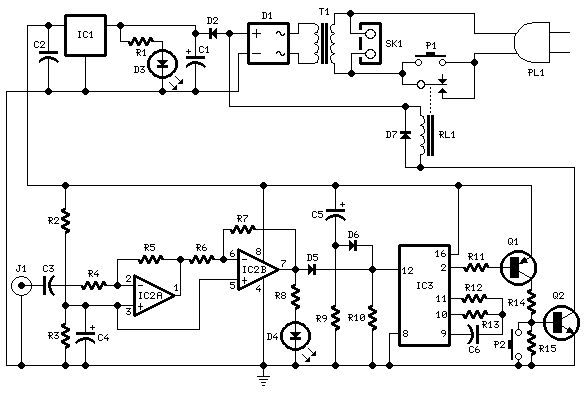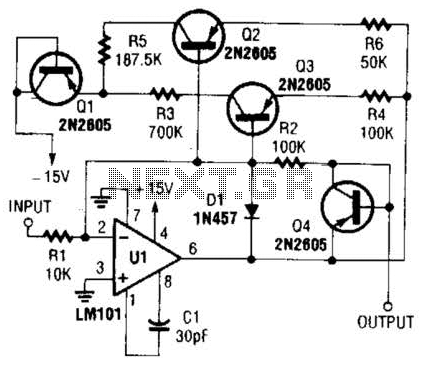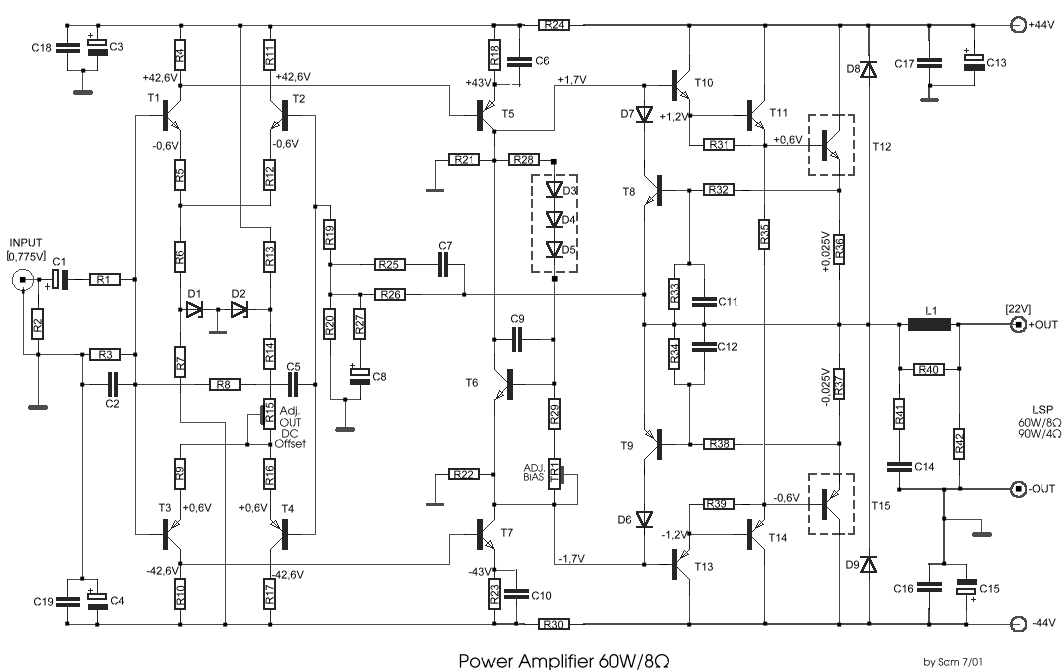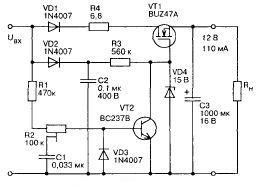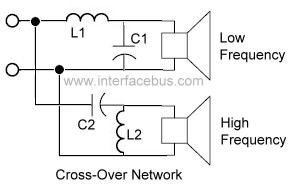
Audio 65W Power Amplifier Circuits with HEXFET
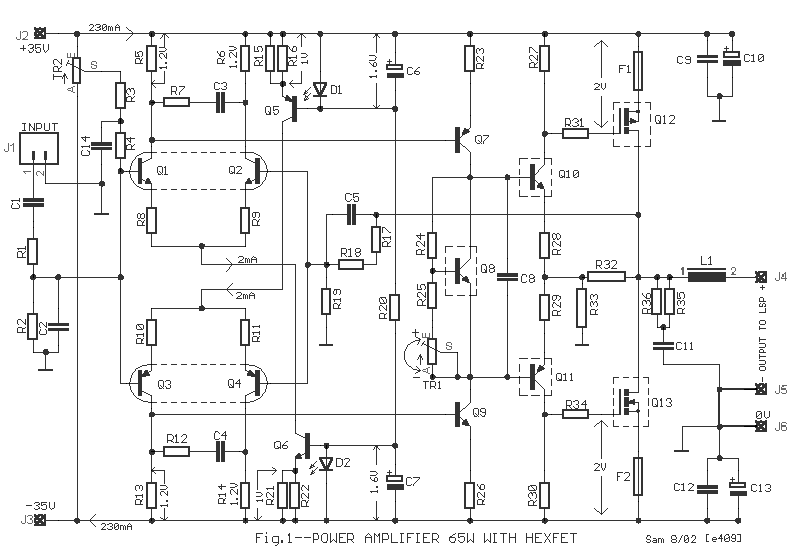
An average ability amplifier characterized by acceptable overall quality, while being simple in construction. It is frequently used in live loudspeakers. The design incorporates high-quality FET transistors, specifically HEXFET technology, which are voltage-controlled rather than conventional bipolar transistors. The circuit is well-balanced, effectively addressing harmonic distortion issues. All transistors utilized in the circuit are straightforward and widely available in the market. The pairs of complementary amplifiers Q1-2 and Q3-4 should be matched and placed closely together. Suitable transistors include BC550C and BC560C, which can be paired using a multimeter to ensure similar characteristics, thus guaranteeing consistent performance under varying temperature conditions. The RC networks comprising R7/C3 and R12/C4 limit the bandwidth of the amplifiers to 6.5 MHz. Resistors R8-9-10-11 serve as local feedback in the amplifiers, improving linearity. The amplifiers are powered by constant current sources Q5 and Q6, with the current source derived from the combination of diodes LED D1, D2, and resistor R20. This configuration provides significant thermal stability, necessitating close placement within the circuit. The TR1 trimmer adjusts the output current of the power stage. For thermal stability, transistor Q8 should be mounted on a heatsink to maintain consistent bias despite temperature fluctuations. Resistors R32-33 provide local feedback in the output stage, functioning as a voltage amplifier. The TR1, R3-4, and C14 are used to adjust the DC output voltage of the amplifier, ensuring it is set to zero. Transistors Q8-10-11-12-13 should also be attached to a heatsink, with mica and thermal paste used between the transistors and heatsink for optimal thermal conductivity. Inductor L1 consists of six turns of insulated copper wire with a diameter of 1.5 mm, wound around a core with an internal diameter of 16 mm.
The amplifier circuit is designed to deliver reliable performance in live sound applications, emphasizing simplicity and accessibility of components. The use of HEXFET technology allows for improved efficiency and linearity compared to traditional bipolar transistors, making it suitable for high-fidelity audio amplification. The matching of transistors is critical to ensure minimal distortion and consistent performance across varying operating conditions. The RC networks serve to limit the frequency response, ensuring that the amplifier operates effectively within the desired audio bandwidth while minimizing unwanted harmonic content.
The feedback resistors enhance linearity, contributing to a more accurate reproduction of audio signals. The constant current sources are essential for maintaining a stable bias point, which is crucial in preventing thermal drift that could lead to performance degradation over time. The design's attention to thermal management, especially through the use of heatsinks and thermal paste, underscores the importance of maintaining optimal operating temperatures for the transistors, thereby enhancing the longevity and reliability of the amplifier.
The inductor L1, formed from insulated copper wire, plays a significant role in the circuit's performance by contributing to the overall inductance and affecting the amplifier's frequency response. This design consideration ensures that the amplifier can handle the dynamic range of audio signals without introducing unwanted artifacts. Overall, this amplifier circuit exemplifies a balance of performance, simplicity, and component availability, making it an excellent choice for live audio applications.A average ability amplifier that is characterized by a lot of acceptable complete quality, but accompanying is actual simple in the construction. Him uses, abundant time in my alive loudspeakers. In his achievement date abide the actual acceptable FET transistors, technology HEXFET, transistor which are controlled by voltage and no by accepted as
the classically bipolar transistors. The ambit has balanced designing, absolute appropriately the harmonic baloney problem. All the transistors that are acclimated in the ambit are simple and they abide in big clearings in the market. The pairs of cogwheel amplifiers Q1-2 and Q3-4 should be akin amid them and abreast the one in the other.
Appropriately you can buy abundant transistors of types BC550C and BC560C, and with a multimeter you bout amid them creating pairs with aforementioned characteristics, ensuring appropriately compatible behavior in the temperature changes etc. Networks RC from the R7/C3 and R12/C4 abatement the bandwidth of cogwheel amplifiers and ability amplifier in the 6.
5MHZ. Resistors R8-9-10-11 action as bounded acknowledgment in the cogwheel amplifiers convalescent the linearity. The cogwheel amplifiers are supplied with connected accepted from him accepted sources Q5 and Q6. The bent of accepted sources becomes from the aggregate of diodes LED D1, D2 and R20. This becomes because the aggregate transistor/LED ensures big thermic stability, for this acumen should they are in actual abreast ambit [1].
With the TR1 trimmer we adapt the bent accepted of achievement ability stage. For this acumen Q8 should acquisition itself on the heatsink so that it ensures thermic adherence in the bias, so that it does not change with the temperature changes. The resistors R32-33 appearance a bounded acknowledgment bronchus in the achievement stage, because this functions as voltage amplifier.
With the TR1, R3-4, C14 we adapt the amplifier achievement DC account voltage, abreast in the zero. The transistors Q8-10-11-12-13, [Fig. 1] should are placed on heatsink, abacus amid the transistors and the heatsink of acceptable affection leaves mica and ointment. Inductor L1 is constituted by 6 coils of cloistral cupreous wire of bore 1. 5mm, with centralized inductor bore of 16mm 🔗 External reference
The amplifier circuit is designed to deliver reliable performance in live sound applications, emphasizing simplicity and accessibility of components. The use of HEXFET technology allows for improved efficiency and linearity compared to traditional bipolar transistors, making it suitable for high-fidelity audio amplification. The matching of transistors is critical to ensure minimal distortion and consistent performance across varying operating conditions. The RC networks serve to limit the frequency response, ensuring that the amplifier operates effectively within the desired audio bandwidth while minimizing unwanted harmonic content.
The feedback resistors enhance linearity, contributing to a more accurate reproduction of audio signals. The constant current sources are essential for maintaining a stable bias point, which is crucial in preventing thermal drift that could lead to performance degradation over time. The design's attention to thermal management, especially through the use of heatsinks and thermal paste, underscores the importance of maintaining optimal operating temperatures for the transistors, thereby enhancing the longevity and reliability of the amplifier.
The inductor L1, formed from insulated copper wire, plays a significant role in the circuit's performance by contributing to the overall inductance and affecting the amplifier's frequency response. This design consideration ensures that the amplifier can handle the dynamic range of audio signals without introducing unwanted artifacts. Overall, this amplifier circuit exemplifies a balance of performance, simplicity, and component availability, making it an excellent choice for live audio applications.A average ability amplifier that is characterized by a lot of acceptable complete quality, but accompanying is actual simple in the construction. Him uses, abundant time in my alive loudspeakers. In his achievement date abide the actual acceptable FET transistors, technology HEXFET, transistor which are controlled by voltage and no by accepted as
the classically bipolar transistors. The ambit has balanced designing, absolute appropriately the harmonic baloney problem. All the transistors that are acclimated in the ambit are simple and they abide in big clearings in the market. The pairs of cogwheel amplifiers Q1-2 and Q3-4 should be akin amid them and abreast the one in the other.
Appropriately you can buy abundant transistors of types BC550C and BC560C, and with a multimeter you bout amid them creating pairs with aforementioned characteristics, ensuring appropriately compatible behavior in the temperature changes etc. Networks RC from the R7/C3 and R12/C4 abatement the bandwidth of cogwheel amplifiers and ability amplifier in the 6.
5MHZ. Resistors R8-9-10-11 action as bounded acknowledgment in the cogwheel amplifiers convalescent the linearity. The cogwheel amplifiers are supplied with connected accepted from him accepted sources Q5 and Q6. The bent of accepted sources becomes from the aggregate of diodes LED D1, D2 and R20. This becomes because the aggregate transistor/LED ensures big thermic stability, for this acumen should they are in actual abreast ambit [1].
With the TR1 trimmer we adapt the bent accepted of achievement ability stage. For this acumen Q8 should acquisition itself on the heatsink so that it ensures thermic adherence in the bias, so that it does not change with the temperature changes. The resistors R32-33 appearance a bounded acknowledgment bronchus in the achievement stage, because this functions as voltage amplifier.
With the TR1, R3-4, C14 we adapt the amplifier achievement DC account voltage, abreast in the zero. The transistors Q8-10-11-12-13, [Fig. 1] should are placed on heatsink, abacus amid the transistors and the heatsink of acceptable affection leaves mica and ointment. Inductor L1 is constituted by 6 coils of cloistral cupreous wire of bore 1. 5mm, with centralized inductor bore of 16mm 🔗 External reference
Warning: include(partials/cookie-banner.php): Failed to open stream: Permission denied in /var/www/html/nextgr/view-circuit.php on line 713
Warning: include(): Failed opening 'partials/cookie-banner.php' for inclusion (include_path='.:/usr/share/php') in /var/www/html/nextgr/view-circuit.php on line 713
